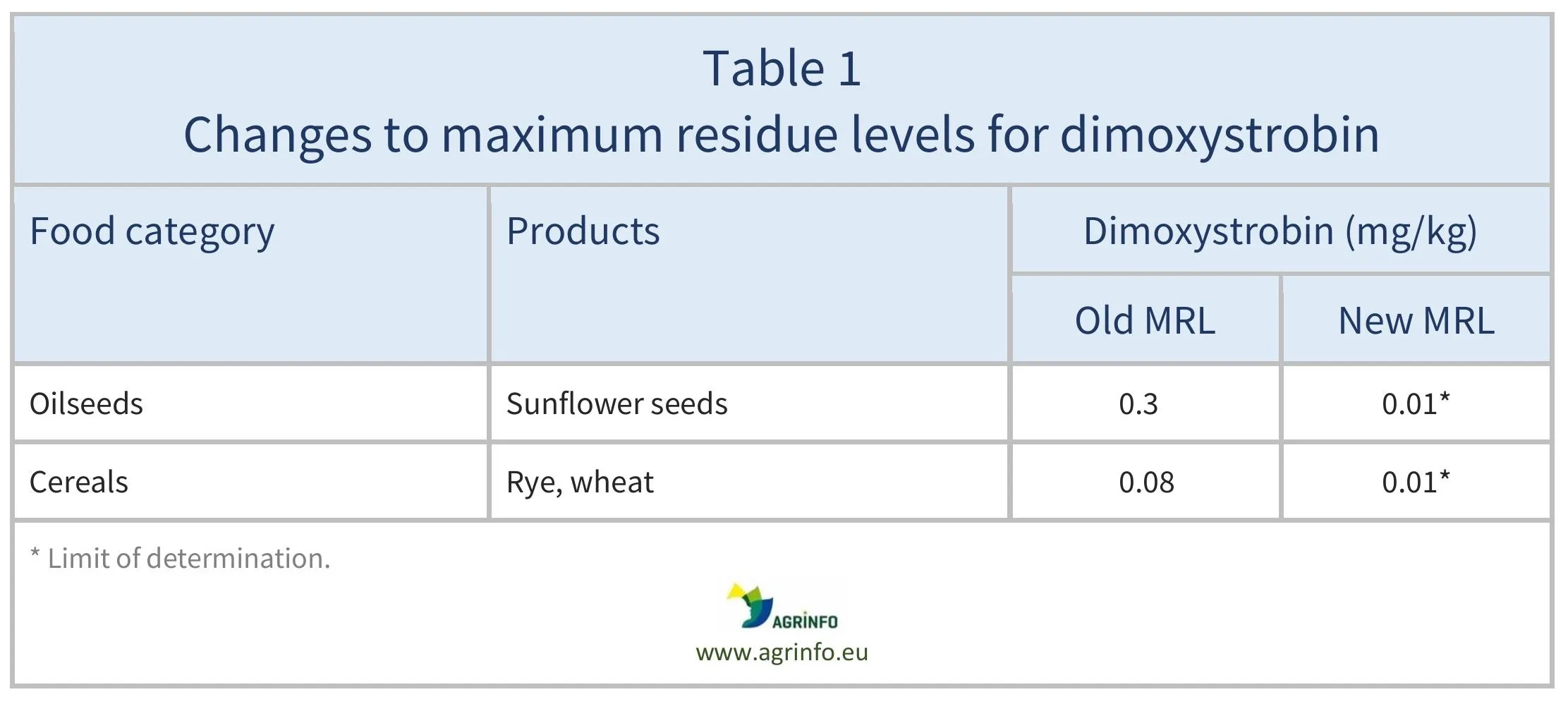Maximum residue levels for dimoxystrobin
- Food safety
- Pesticide MRLs
Summary
The European Commission has informed the World Trade Organization Sanitary and Phytosanitary Measures (WTO SPS) Committee that it intends to lower the maximum residue levels (MRLs) for dimoxystrobin to the limit of determination (LOD) on all products (G/SPS/N/EU/801). (The LOD is the lowest level that can be detected using the most modern and reliable analytical methods.) Revised MRLs will have impacts particularly on exporters of sunflower seeds, rye, and wheat.
EU proposes to amend MRLs for dimoxystrobin
Draft Commission Regulation amending Annexes II and V to Regulation (EC) No 396/2005 of the European Parliament and of the Council as regards maximum residue levels for dimoxystrobin, ethephon and propamocarb in or on certain products
Draft Annex: PLAN/2024/1305 R2 DRAFT
Update
The European Commission has informed the World Trade Organization Sanitary and Phytosanitary Measures (WTO SPS) Committee that it intends to lower the maximum residue levels (MRLs) for dimoxystrobin to the limit of determination (LOD) on all products (G/SPS/N/EU/801). (The LOD is the lowest level that can be detected using the most modern and reliable analytical methods.) Revised MRLs will have impacts particularly on exporters of sunflower seeds, rye, and wheat.
Impacted Products
Sunflower seeds, rapeseeds/canola seeds, mustard seeds, rye, wheat, animal products (muscle, fat, liver, kidney, edible offals) from swine, cattle, sheep, goats, horses, poultry, other farmed animals, birds’ eggs (chicken, duck, geese, quail), amphibians and reptiles, terrestrial invertebrate animals, wild terrestrial vertebrate animals
What is changing?
The EU proposes to amend the MRLs for dimoxystrobin as summarised in Table 1.
In addition, the EU proposes to lower the LOD for dimoxystrobin on oilseeds and oil fruits from 0.05 to 0.01 mg/kg, and on animal products from 0.03 to 0.01 mg/kg.
Why?
Because the EU’s approval of dimoxystrobin has not been renewed (Regulation (EU) 2023/1436), the MRLs have been lowered to the LOD on all products. See Dimoxystrobin: non-renewal of EU approval.
The EU reference laboratories for pesticide residues were consulted to assess the need to adapt certain LODs. For dimoxystrobin, the laboratories have proposed product-specific LODs that are analytically achievable, ensuring compliance with updated safety and monitoring standards.
Timeline
New MRLs are expected to apply from approximately January 2026.
Recommended Actions
Suppliers of sunflower seeds, rye, and wheat in particular should evaluate their current use of dimoxystrobin and explore possible alternative solutions in anticipation of these MRL changes.
Feedback on the EU’s proposal (G/SPS/N/EU/801) closed on 3 February 2025.
Background
MRLs are set in accordance with the rules set out in Regulation 396/2005. For information on current MRLs for other substances, please consult the EU Pesticide Residues database.
Resources
Commission Implementing Regulation (EU) 2023/1436 concerning the non-renewal of the approval of the active substance dimoxystrobin
Sources
Draft Commission Regulation as regards maximum residue levels for dimoxystrobin, ethephon and propamocarb in or on certain products
Draft Annex: PLAN/2024/1305 R2 DRAFT
Tables & Figures

Source: based on Draft Annex
Disclaimer: Under no circumstances shall COLEAD be liable for any loss, damage, liability or expense incurred or suffered that is claimed to have resulted from the use of information available on this website or any link to external sites. The use of the website is at the user’s sole risk and responsibility. This information platform was created and maintained with the financial support of the European Union. Its contents do not, however, reflect the views of the European Union.
EU proposes to amend MRLs for dimoxystrobin
Commission Implementing Regulation (EU) 2023/1436 concerning the non-renewal of the approval of the active substance dimoxystrobin
What is changing and why?
Because the EU’s approval of dimoxystrobin has not been renewed, the maximum residue levels (MRLs) have been lowered to the limit of determination (LOD) on all products. (The LOD is the lowest level that can be detected using the most modern and reliable analytical methods.) See Dimoxystrobin: non-renewal of EU approval.
The changes are set out in Table 1.
In addition, the EU proposes to lower the LOD for dimoxystrobin on oilseeds and oil fruits from 0.05 to 0.01 mg/kg, and on animal products from 0.03 to 0.01 mg/kg.
Actions
Suppliers of sunflower seeds, rye, and wheat in particular should evaluate their current use of dimoxystrobin and explore possible alternative solutions in anticipation of these MRL changes.
Feedback on the EU’s proposal (G/SPS/N/EU/801) closed on 3 February 2025.
Timeline
New MRLs are expected to apply from approximately January 2026.
Tables & Figures

Source: based on Draft Annex
Disclaimer: Under no circumstances shall COLEAD be liable for any loss, damage, liability or expense incurred or suffered that is claimed to have resulted from the use of information available on this website or any link to external sites. The use of the website is at the user’s sole risk and responsibility. This information platform was created and maintained with the financial support of the European Union. Its contents do not, however, reflect the views of the European Union.
